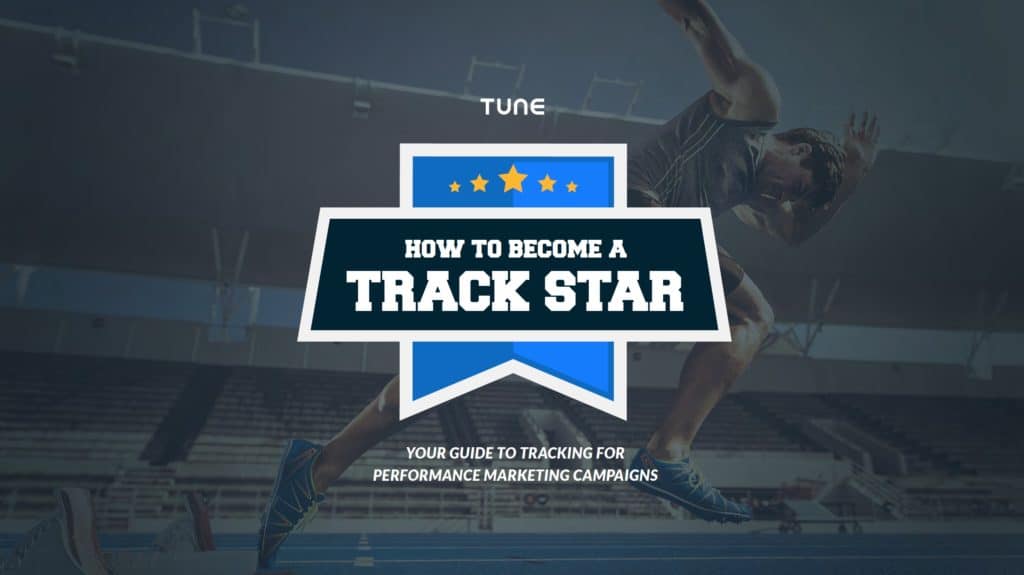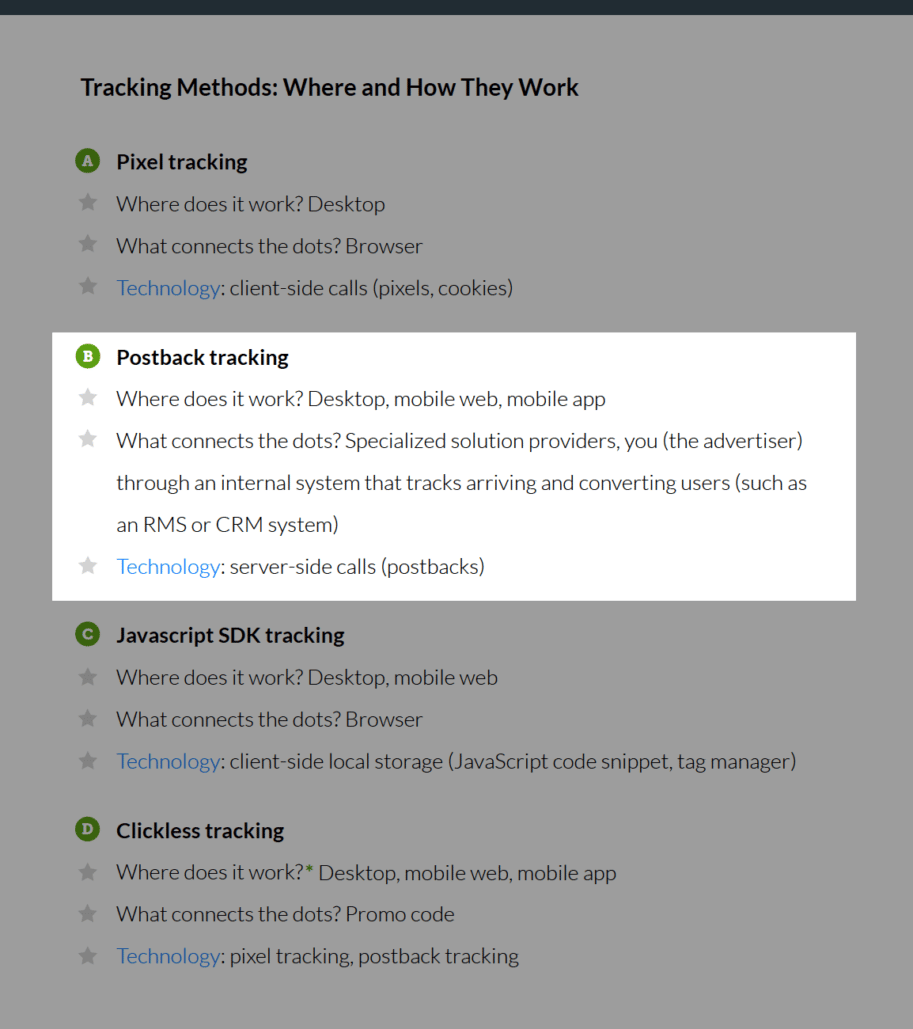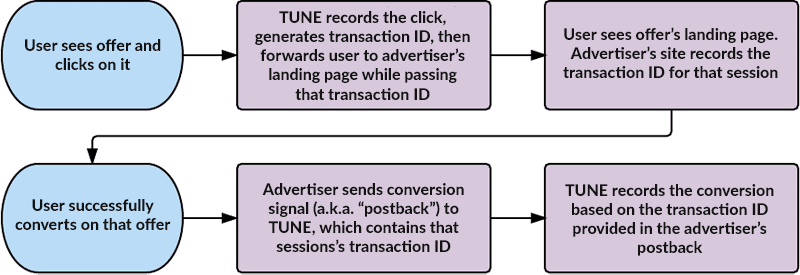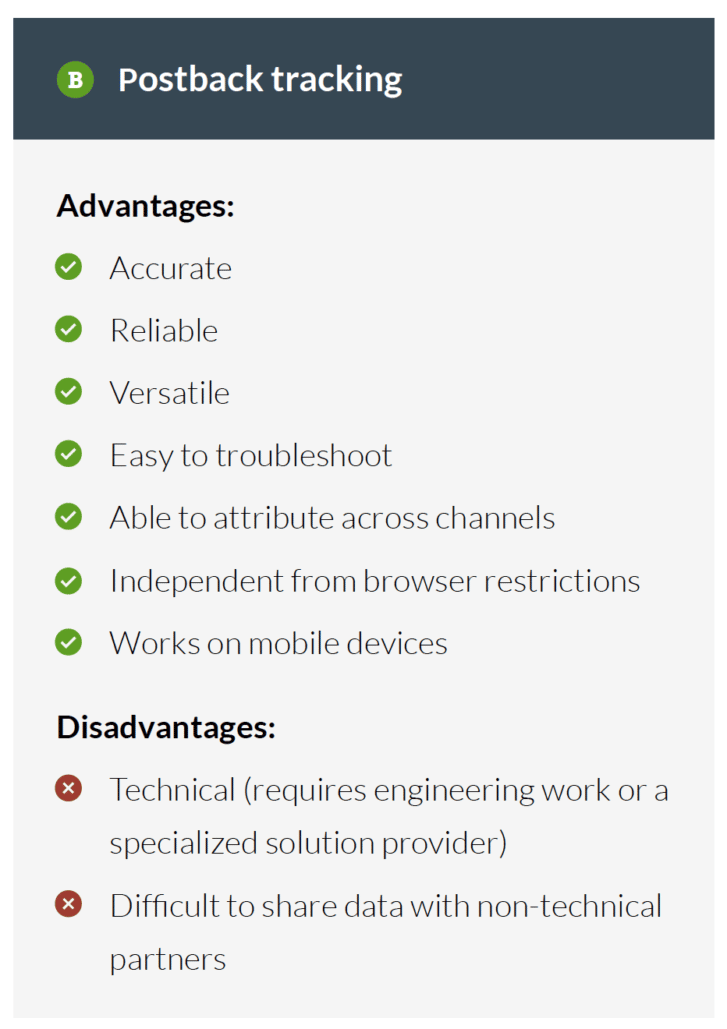
Time for Part 2 of our Capture Every Conversion blog series! In this series, we’re taking a look at four digital tracking methods from our newest white paper, How to Become a Track Star: Your Guide to Tracking for Performance Marketing Campaigns.
In Part 1, we covered the ins and outs of pixel tracking. We also explained the risks associated with this method, and why marketers should avoid pixel tracking in the future. In this post, we will be exploring the second of our four tracking methods: postback tracking.
What Is Postback Tracking?
Also called server postback, server-side, server-to-server, and server-based tracking, postback tracking is most notable for what it is not: reliant on cookies and web browsers. Instead, postback tracking uses servers to store and send the information needed to attribute conversions. No data is stored on a user’s computer.

Postback tracking works by generating and storing a unique identifier (ID) when a user completes a desired action, like clicking on an ad. When that same user later converts, the unique ID is matched back to the user. This is done through direct communication by two or more servers, hence server-to-server tracking.

Since postback tracking doesn’t need a web browser to function, it works in environments where cookies aren’t available — on smartphones, for instance. In fact, postback tracking was originally developed for use in mobile app install campaigns, and it’s still the standard for conversion tracking on mobile. Marketers on desktop have only caught on to this method in recent years as browsers have started to restrict the third-party cookies they need for pixel tracking.
With postback tracking, each party involved in a campaign must be able to store data on a server and send it directly to the other party. This functionality is handled by tracking software, which can be provided by a third party like TUNE, built in-house, or accessed through a traditional affiliate network.
Postback Tracking Capabilities
Postback tracking is the most accurate, granular, and reliable conversion tracking method available to performance marketers today. Period.
To understand why, you have to understand how postback tracking works. This is easiest to do when it’s compared to pixel tracking. We’ll summarize below; for more details, see “Server Postback Tracking Explained” on TUNE Help.
Let’s say you’re an advertiser. A user visits your affiliate’s site, where they click on a link to your product:
- In postback tracking, that click goes directly to the tracking software server that you and your affiliate used to set up your campaign. The server records the click, generates a unique ID, and sends the ID to you.
- Your server stores that ID however you choose (in a database, as a variable on an e-commerce site, in an SDK in a mobile app, etc.).
- Upon conversion, your server sends the ID back to the tracking software (or “fires a postback”), and a conversion is recorded.
Compare that to pixel tracking:
- In pixel tracking, it’s basically the same up until the ID is sent from the tracking server.
- At this point, the ID is not sent to you — instead, it’s stored in a cookie in the user’s browser.
- Upon conversion, the browser loads a conversion pixel, which sends the ID in the user’s cookie back to the tracking server. If it matches, a conversion is recorded.
Postback tracking, unlike pixel tracking, bypasses browsers and cookies altogether. It can be used to measure any channel where servers can send information via code. It’s as robust and flexible as you need it to be, because you control how the data is passed, organized, and stored. This also makes it easy to troubleshoot, and easier to secure against fraud.
Sound too good to be true? Well, it is, and it isn’t. All the perks are there, but they come with a price. Because it involves more complex processes and technology — and not just a simple code snippet in a browser — postback tracking can be more difficult to implement than pixel tracking. It may require engineering expertise and development, or a specialized solution (like TUNE), both for you and your partners. That said, the payoff cannot be overstated.
When to Use Postback Tracking
After reading the above, isn’t the real question, when should you not use postback tracking?

This method can handle most situations for the majority of performance marketers. These include:
- Tracking desktop web campaigns
- Tracking mobile app campaigns, including installs and in-app events
- Tracking across channels and platforms
If you have tracking needs outside of these big buckets, supplementing your server-side tracking with a specialized method to handle just that use case is encouraged. For example, here at TUNE, we recommend using postback tracking as your go-to method, and adding solutions or partners to handle the following situations:
- Campaigns using promo codes
- Tracking online to offline
- Call tracking and other specialized channel strategies
In all honesty, we haven’t yet found a situation where postback tracking isn’t possible. However, there may be times where you will need to use pixel tracking because a partner may require their pixel to be placed.
In Conclusion
In our new white paper, How to Become a Track Star, we talk about conversion tracking in terms of campaign health. If your tracking is strong, your campaign will be healthy. If your tracking is weak, your campaign is less effective and more susceptible to harm. It’s our way of making a dense, technical, often confusing subject a little more fun — while still getting the important bits across.
Now that we’ve covered postback tracking, we’re moving on to a specialized solution in Part 3: JavaScript SDK tracking, which is used for measuring conversions in mobile web. Check back soon for the next installment!

While you’re here, check out the rest of our How to Become a Track Star series, where we cover the pros and cons of four popular tracking methods for affiliate programs and performance marketing campaigns.
- Part 1: Pixel Tracking
- Part 2: Server Postback Tracking
- Part 3: JavaScript SDK Tracking
- Part 4: Clickless Tracking
If you’re ready to get your own affiliate program started, request a demo of the TUNE Partner Marketing Platform today.
Author
Becky is the Senior Content Marketing Manager at TUNE. Before TUNE, she handled content strategy and marketing communications at several tech startups in the Bay Area. Becky received her bachelor's degree in English from Wake Forest University. After a decade in San Francisco and Seattle, she has returned home to Charleston, SC, where you can find her strolling through Hampton Park with her pup and enjoying the simple things in life.



Leave a Reply
You must be logged in to post a comment.